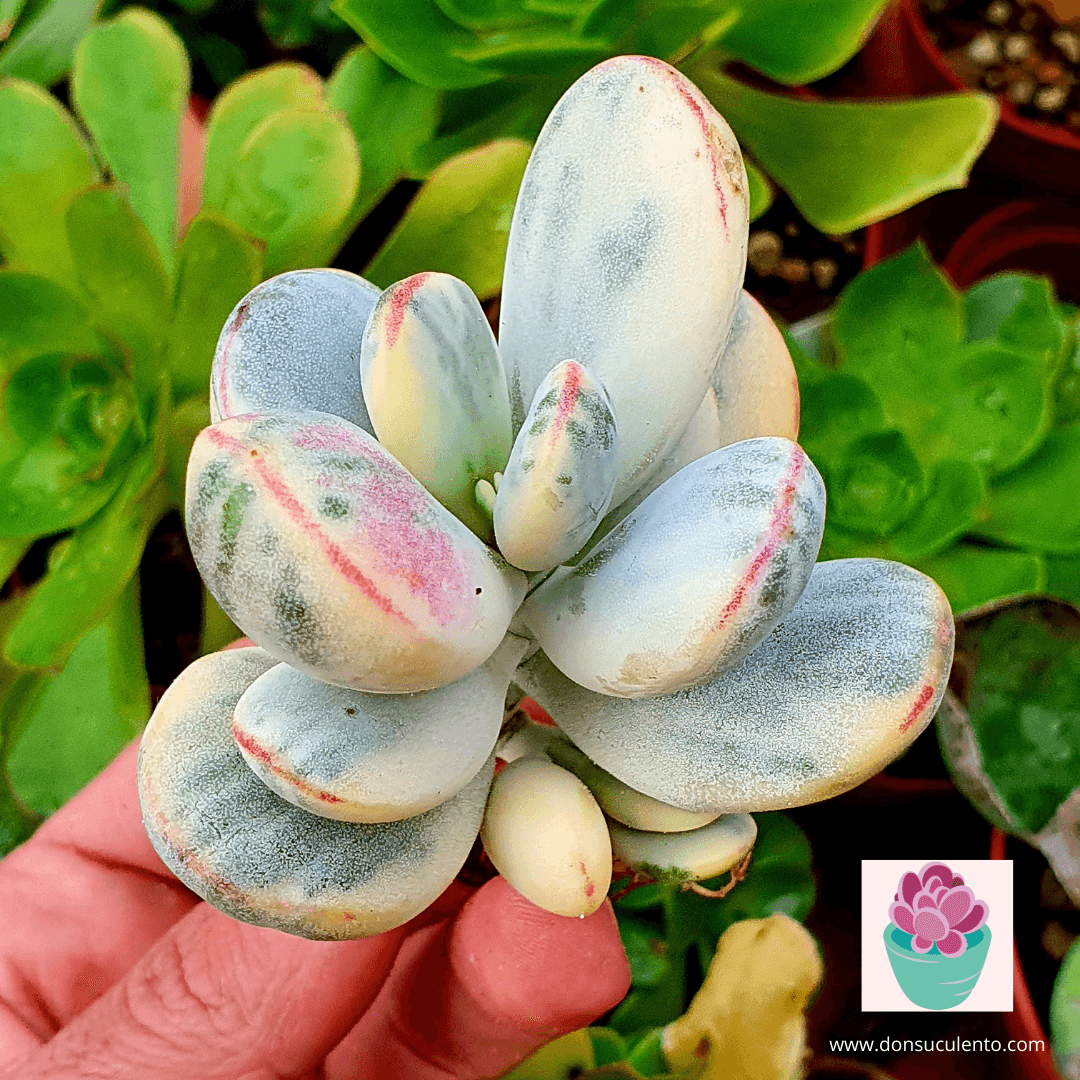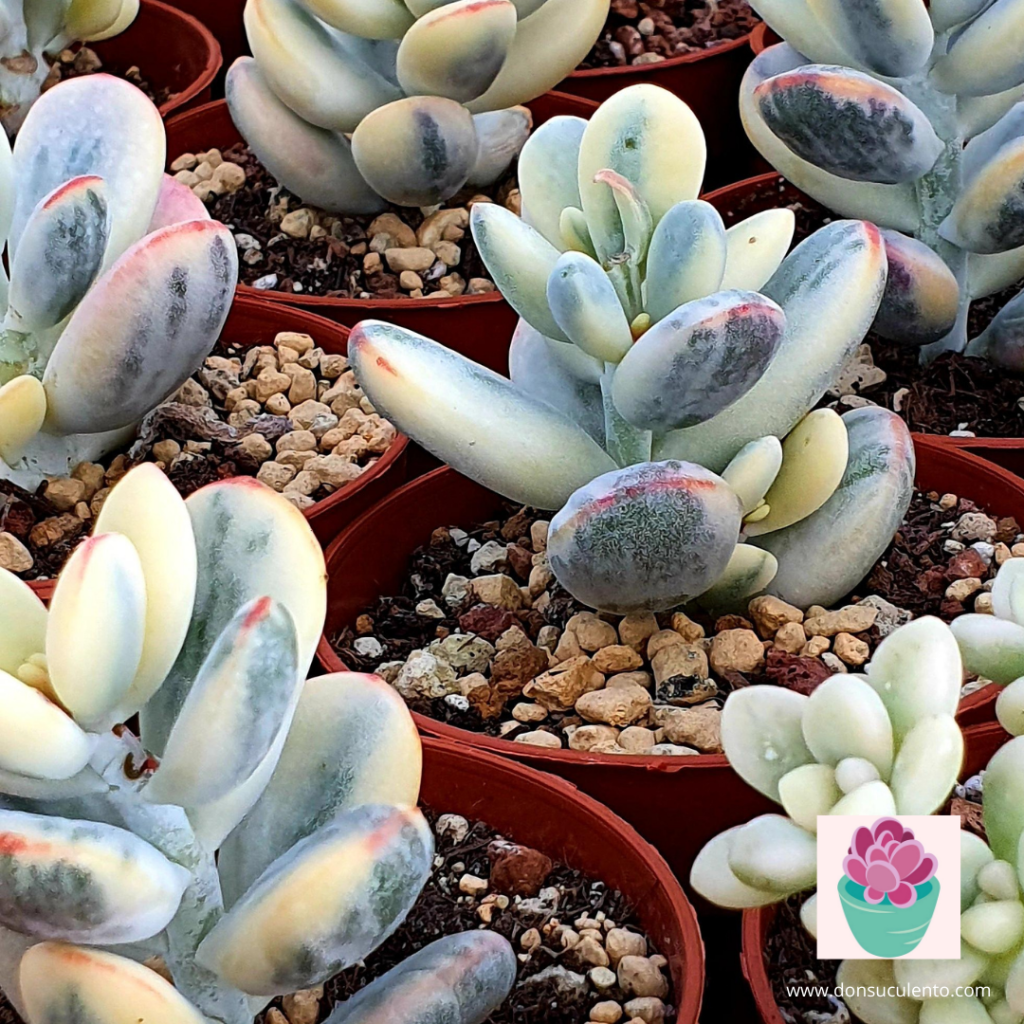
How to take care of my variegated cotyledon orbiculata var oophilla and not die trying?
Share
How to take care of my variegated cotyledon orbiculata var oophilla so that it doesn't die trying?
It is one of the five succulent plants that I consider to be the most delicate in cultivation. It is very easy to make it feel bad, however if you manage to make it feel good, it will have a fast and vigorous growth, in short, a gift for the eyes. It is a difficult plant to adapt to, but once it does, it thrives. They suffer a lot during travel, especially in summer. Here are some tips for good maintenance:
Location
It is a 100% outdoor plant. To keep it inside you would need; lights, ventilation etc. It does not tolerate temperature changes well, it cannot have heating or air conditioning.
Like most cotyledons, it rests in summer when temperatures are high and is most active in autumn/winter/spring. Although with a mild climate you can maintain activity throughout the year.
Being a variegated plant, especially the young specimens, from May it must be protected from the sun and placed in a location that is filtered or directly in the shade, where it is bright until the end of September.
He likes stability, not continually changing locations.
Moisture and irrigation
When they are young, it is one of the most susceptible plants to humidity. It is necessary to avoid watering the leaves directly, until they are adult and stable specimens. It does not need to be watered abundantly.
It is not possible to irrigate with minimum temperatures lower than 8º or above 32º Celsius continuously. The plant is with the activity at rest and does not need water, if it had it it would become the perfect broth for the fungi to proliferate in both situations.
Substrate
Requires a substrate that is as mineral as possible to avoid waterlogging and to absorb excess moisture. A 50% universal substrate and another 50% volcanic gravel, pomice or akamada of small volumetry so that it does not retain humidity, it is the perfect combination. I would avoid perlite and especially vermiculite, both are moisture retainers.

How to take care of your Cotyledon Orbiculata Var Oophylla Variegata, so it doesn't die in the process.
This variegation is one of the five succulents that I consider to be the most delicate. To make this plant uncomfortable is very easy. However, if you make it feel comfortable, the succie will grow fast and vigorously; something beautiful to watch. This plant may not adapt itself well, but once it does, it will grow stronger. Also, bear in mind that this succulent suffers a lot when traveling, especially during the summer. Check the following tips for good maintenance:
Location
The Cotyledon is a 100% outdoor plant. You will need lights and ventilation to keep it inside. Your plant doesn't stand temperature changes and can't be in a heated environment or where the AC is on.
As the majority of the Cotyledon variegations, this succulent remains during the summer when the temperatures are high, and it's more active in the fall/winter/spring. However, you might keep it more active throughout the year if your plant is in a mild climate.
From May out, protect your Cotyledon from the sun (especially younger plants). Using a shade cloth or placing it in the shade, where it's bright, is the best place to keep your succulent. Don't forget to do this at least till September.
This succie loves stability and doesn't like to be changed locations often.
Humidity and watering
This variegation, when it is young, is one of the most vulnerable to humidity.You should avoid watering the leaves directly, not until the plant has reached its maturity and is stable There is no need to water your plant in abundance.
You should also avoid watering this succulent constantly under minimum temperatures of 8 degrees Celsius or above 32. This plant is continuously active even without water. If you failed to do this, in both scenarios, fungi would grow.
Substrate
This succie needs a high-level mineral substrate. The reason for this is to avoid all the flooding and soaking of the humidity in excess. The perfect combination is using 50% of a universal substrate and another 50% of volcanic gravel, a small volumetry of pumice or Akamada, so humidity doesn't remain. As a piece of advice, stay away from perlite and mostly vermiculite because they are great humidity keepers.


